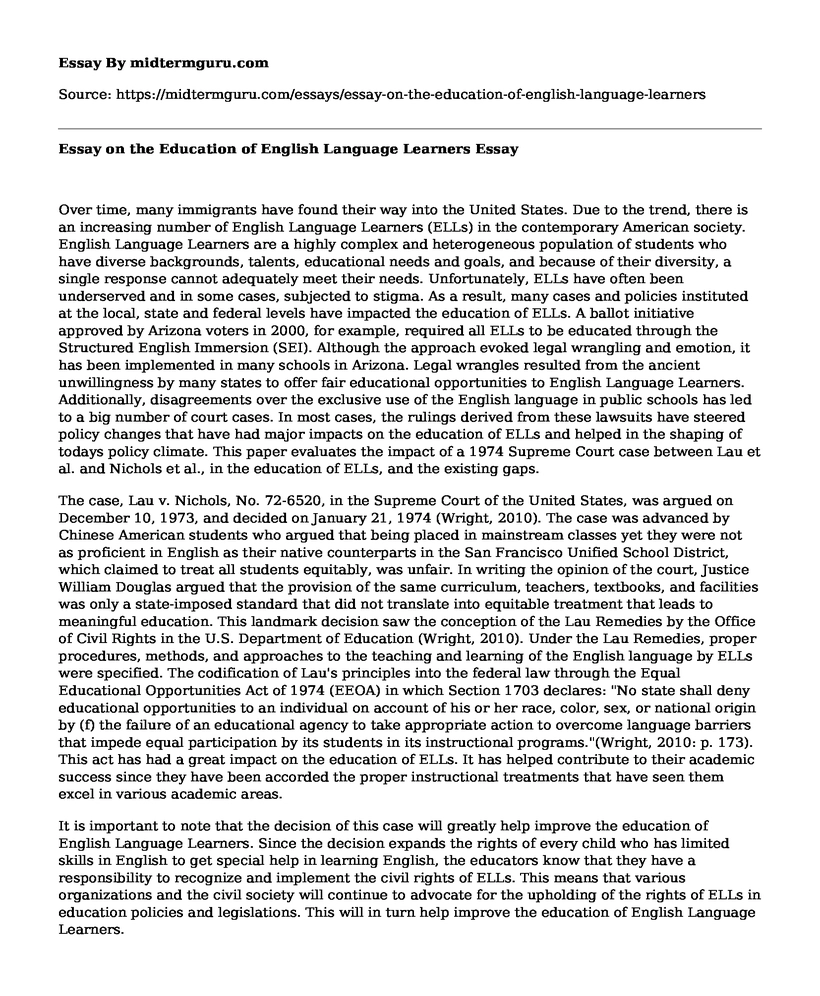Over time, many immigrants have found their way into the United States. Due to the trend, there is an increasing number of English Language Learners (ELLs) in the contemporary American society. English Language Learners are a highly complex and heterogeneous population of students who have diverse backgrounds, talents, educational needs and goals, and because of their diversity, a single response cannot adequately meet their needs. Unfortunately, ELLs have often been underserved and in some cases, subjected to stigma. As a result, many cases and policies instituted at the local, state and federal levels have impacted the education of ELLs. A ballot initiative approved by Arizona voters in 2000, for example, required all ELLs to be educated through the Structured English Immersion (SEI). Although the approach evoked legal wrangling and emotion, it has been implemented in many schools in Arizona. Legal wrangles resulted from the ancient unwillingness by many states to offer fair educational opportunities to English Language Learners. Additionally, disagreements over the exclusive use of the English language in public schools has led to a big number of court cases. In most cases, the rulings derived from these lawsuits have steered policy changes that have had major impacts on the education of ELLs and helped in the shaping of todays policy climate. This paper evaluates the impact of a 1974 Supreme Court case between Lau et al. and Nichols et al., in the education of ELLs, and the existing gaps.
The case, Lau v. Nichols, No. 72-6520, in the Supreme Court of the United States, was argued on December 10, 1973, and decided on January 21, 1974 (Wright, 2010). The case was advanced by Chinese American students who argued that being placed in mainstream classes yet they were not as proficient in English as their native counterparts in the San Francisco Unified School District, which claimed to treat all students equitably, was unfair. In writing the opinion of the court, Justice William Douglas argued that the provision of the same curriculum, teachers, textbooks, and facilities was only a state-imposed standard that did not translate into equitable treatment that leads to meaningful education. This landmark decision saw the conception of the Lau Remedies by the Office of Civil Rights in the U.S. Department of Education (Wright, 2010). Under the Lau Remedies, proper procedures, methods, and approaches to the teaching and learning of the English language by ELLs were specified. The codification of Lau's principles into the federal law through the Equal Educational Opportunities Act of 1974 (EEOA) in which Section 1703 declares: "No state shall deny educational opportunities to an individual on account of his or her race, color, sex, or national origin by (f) the failure of an educational agency to take appropriate action to overcome language barriers that impede equal participation by its students in its instructional programs."(Wright, 2010: p. 173). This act has had a great impact on the education of ELLs. It has helped contribute to their academic success since they have been accorded the proper instructional treatments that have seen them excel in various academic areas.
It is important to note that the decision of this case will greatly help improve the education of English Language Learners. Since the decision expands the rights of every child who has limited skills in English to get special help in learning English, the educators know that they have a responsibility to recognize and implement the civil rights of ELLs. This means that various organizations and the civil society will continue to advocate for the upholding of the rights of ELLs in education policies and legislations. This will in turn help improve the education of English Language Learners.
In conclusion, although a lot has been done to ensure equitable provision of education in the United States, there are still some gaps derived from the Lau v. Nichols case. The court did not specify the approach that schools should apply in the education of ELLs. As such, many ELLs still languish in schools that lack appropriate textbooks, adequate assessments, enough bilingual educators, and teachers who are ready to teach them. Consequently, these students are unable to comprehend the content. It is, therefore, important for policy makers to consider giving more attention to the distinct approaches in the education of ELLs.
Reference
Wright, W. E. (2010). Foundations for teaching English language learners: Research, theory, policy, and practice. Caslon Pub..
Cite this page
Essay on the Education of English Language Learners. (2021, Jun 17). Retrieved from https://midtermguru.com/essays/essay-on-the-education-of-english-language-learners
If you are the original author of this essay and no longer wish to have it published on the midtermguru.com website, please click below to request its removal:
- The U-Shaped Acquisition
- Improving Learning Through Discussions in the Online Classroom
- Special Teaching in Higher Education - Paper Example
- Essay on Psychological Factors That Influence the Performance of Students in Schools
- Essay Sample on Early Recognition of Developmental Disabilities
- Paper Example on Behavioral Issues for Deaf and Hard of Hearing Students
- Media's Ubiquitous Presence in Children's Lives: Impact and Transformation - Essay Sample







